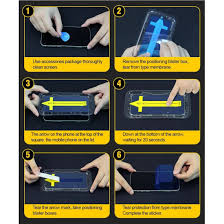Preventing Screen Damage & several reputable brands that offer high-quality iPhone screen protectors
Preventing Screen Damage: The primary purpose of a screen protector is to keep the device's screen safe from scratches, cracks, and other physical damages. However, if the protector is not removed correctly, it may inadvertently damage the screen. Improper removal techniques, such as the use of excessive force or sharp objects, may scratch or break the screen, rendering it less functional or unusable. By properly removing the glass screen protector, you can reduce the risk of damaging the screen and ensure its longevity.
👉There are several reputable brands that offer high-quality iPhone screen protectors. Here are a few popular options
mFilm: Known for its tempered glass screen protectors, mFilm offers excellent protection against scratches and drops. They offer precise fit and high transparency for optimum touchscreen sensitivity.

Spigen: Spigen is a well-known brand that offers a range of screen protectors for iPhones. They offer durable tempered glass protectors with features like fingerprint resistance, bubble-free installation, and edge-to-edge coverage.
JETech: JETech offers affordable yet reliable screen protectors for the iPhone. Their tempered glass protectors offer scratch resistance, high clarity and easy installation with an installation frame for precision.
ZAGG: ZAGG offers high-quality screen protectors, including their popular InvisibleShield series. Their protectors include advanced impact and scratch protection, self-healing properties and smooth touch sensitivity.
Belkin: Belkin is a trusted brand that offers screen protection solutions for iPhones. Their screen protectors offer exceptional clarity, scratch resistance, and easy installation with a special adhesive.
Otterbox: Known for its sturdy phone cases, Otterbox also offers screen protectors that offer reliable protection against scratches and impacts. Their protectors are designed to work seamlessly with their cases for comprehensive device protection.
👉Preserving Touchscreen Sensitivity: Glass screen protectors often have a special coating that maintains the responsiveness and sensitivity of the touchscreen. When removing the protector, it is important to do so without compromising this coating. Handling the removal process incorrectly may remove or damage the coating, resulting in loss of touchscreen functionality. By following proper removal techniques, you can preserve the screen's sensitivity and ensure a smooth user experience.
👉Avoiding adhesive residue: Glass screen protectors generally use adhesives to stick to the screen of the device. If the protector is not removed properly, adhesive residue may remain on the screen surface. This residue can become sticky, attract dust and debris, and create an uneven appearance on the screen. Also, if a new screen protector is applied over adhesive residue, it may not stick properly, resulting in bubbles or an unsightly appearance. Proper removal techniques help minimize adhesive residue, ensuring a clean and smooth screen surface for future use.
👉Convenience of easy replacement: There are various reasons why one might need to remove a glass screen protector, such as wanting to replace it with a new one or to access the device's screen for maintenance or repair. By removing the protector properly, you make it easier to replace it with a new one when needed. Proper removal technique allows for a smooth transition, ensuring that the new screen protector adheres properly and performs optimally.
👉Maintaining the aesthetics of the device: A broken or damaged glass screen protector can significantly affect the aesthetics of the device. Properly removing the protector helps in maintaining the visual appeal of the device's screen. By carefully peeling off the protector without causing any damage, you can ensure that the screen remains clean, clear and attractive to look at.



Comments
Post a Comment